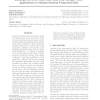388 search results - page 8 / 78 » The covering number in learning theory |
KDD
2009
ACM
14 years 2 months ago
2009
ACM
In this paper, we consider a novel scheme referred to as Cartesian contour to concisely represent the collection of frequent itemsets. Different from the existing works, this sche...
SGAI
2005
Springer
14 years 24 days ago
2005
Springer
This paper details the application of geometric proportional analogies in the sub-classification of polygons within a topographic (land cover) map. The first part of this paper co...
IAT
2010
IEEE
13 years 4 months ago
2010
IEEE
Abstract--This article deals with the issue of concept learning and tries to have a game theoretic view over the process of cooperative concept learning among agents in a multi-age...
COLT
1993
Springer
13 years 11 months ago
1993
Springer
The Vapnik-Chervonenkis (V-C) dimension is an important combinatorial tool in the analysis of learning problems in the PAC framework. For polynomial learnability, we seek upper bou...
ICML
2004
IEEE
14 years 8 months ago
2004
IEEE
Inductive learning of first-order theory based on examples has serious bottleneck in the enormous hypothesis search space needed, making existing learning approaches perform poorl...

